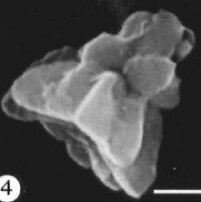Sphenolithus tintinnabulum
Set number: 917
-
1
-
2
-
3
-
4
10µm
Set number: 918
-
1
-
2
-
3
-
4
10µm
Set number: 919
-
1
-
2
-
3
-
4
10µm
Set number: 922
-
1
-
2
-
3
-
4
10µm
Sphenolithus tintinnabulum Maiorano & Monechi, 1997
Small [3.0-5.0µm] bell-shaped sphenolith having diminutive clustered apical cycle resembles a bouquet of flowers at 45° [its segments radiating upward-outward distally]. The apical cycle with axial c-axis shows maximum birefringence at 45° but extinct (dim) at 0°.
The frustum shape proximal cycle predominates the lateral cycle and the apical spine. The height of the proximal cycle with a clearly concave base is always distinctly greater than the height of the lateral and apical cycles combined.
The inner end of the irregular quadrilateral segments of the proximal cycle joins most of their length along the longitudinal axis but not joined nearer the proximal end, thus creating a conical proximal cavity.
Sphenolithus tintinnabulum differs from Sphenolithus disbelemnos Fornaciari & Rio, 1996 and Sphenolithus compactus Backman, 1980 by its bell shape and smaller size. Moreover, the base of Sphenolithus tintinnabulum is distinctly concave.
Backman, J. 1980. Miocene-Pliocene nannofossils and sedimentation rates in the Hatton-Rockall Basin, NE Atlantic Ocean. Stockholm Contributions in Geology 36: 1-91.
Fornaciari, E., Rio, D., 1996. Latest Oligocene to early Middle Miocene quantitative calcareous nannofossil biostratigraphy in the Mediterranean region. Micropaleontology 42(1), 1-37
Maiorano, P., Monechi, S., 1997. New Early Miocene species of Sphenolithus Deflandre, 1952 from the North Atlantic Ocean. Journal of Nannoplankton Research 19(2), 103-107.
